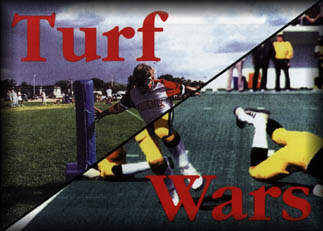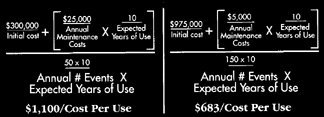Team
Accommodations
| Sport
Source Directory | Canadian Sport Tournaments | CDN Sport Associations
A
FITNESS, RECREATIONAL FACILITY AND PARKS & RECRATION WEB MAGAZINE
 You
are about to read one of many articles in Cornerstones Web Magazine's
Editorial Library.
With-in
this sites 200+ pages is an In-Depth On-Line Buyers Guide, where
you can review product information on many
You
are about to read one of many articles in Cornerstones Web Magazine's
Editorial Library.
With-in
this sites 200+ pages is an In-Depth On-Line Buyers Guide, where
you can review product information on many
of the major companies with-in the trade, all with just the click
of a button.
Thank
You for visiting Cornerstones, scroll down to read the article
you requested.

by
Dave Parker
There
are a large number of qualified contractors available when considering
the natural grass option, and depending on the sport to be played
a variety of grass species possible. When considering the artificial
turf option the two major types commonly used on athletic fields
are AstroTurf and SuperTurf. Both are proven products and have
a large number of installations. SuperTurf is the newer product
with the first field placed about 1975, while AstroTurf installations
began in 1965. There have been a number of improvement made in
both turf's since the first generation of surfaces.
While
a number of individual theories exist regarding injuries on natural
grass as opposed to synthetic turf, according to a number of national
studies on athletic injuries there is no significant difference
in the number of major injuries reported while participating on
grass or artificial turf fields. A study by the NFL concluded
that there were slightly fewer serious injuries on artificial
turf compared to natural grass, though synthetic fields reported
more minor injuries. (Serious injury is one causing a player to
miss one or two games).
A
primary consideration when comparing artificial vs. natural is
the amount and type of usage the field/facility is proposed to
have. Synthetic turf fields provide a stadium with a surface that
can be used with unlimited frequency for various sports (football,
baseball, soccer, lacrosse, etc.) plus miscellaneous events (band
competitions, concerts, drill teams, intra-murals, etc.) Even
with frequent usage and inclement weather, synthetic fields remain
consistent for major events.
In
order to maintain natural grass surfaces in good condition, it
is recommended that there use is limited to 10-15 football games
per year, or one other sporting function per week. And, a game
played on a natural grass surface in inclement weather, rainy
weather can damage the turf for an extensive period, or require
additional expense to speed up the restoration process.
NATURAL
GRASS (Cell-System, Sand Based)
Initial
Capital Cost
a.
Excavate existing site, install new drainage and irrigation systems,
install sand fill and grow grass (seed/sod)
b.
Provide necessary equipment to maintain and operate the system.
c.
Cost for contractor to maintain field during initial growth period.
Future
Capital Cost
a.
Periodic equipment replacement - can be handled by periodic purchase
or as an annualized cost on a depreciated basis.
b.
Periodic replacement of irrigation and drainage piping, equipment,
etc.
c.
Periodic replacement of field tarps.
Annualized
Operating Cost
a.
Materials required include: water, fertilizer, fungicides/pesticides,
other chemicals/lime, striping paint/vegetable dyes, fuel/oil/etc.
to operate equipment, seed and or re-sod materials.
b.
Labour to apply materials, related functions plus mowing, aerating,
divot replacement, area sod replacement, reseeding etc.
c.
Equipment In addition to capital expenditures rental equipment
may be needed such as: portable cranes to remove goal posts, portable
stages etc. Aeration, sod cutting equipment, etc.

 Cost
for a natural grass field ranges from $300,00 and up. Maintenance
begins at $30,000 and can go as high as $100,000/year. The industry
standard for expected years of use for synthetic turf is 10 years,
maintenance is $5,000/year, including the cost of a power sweeper
pro-rated over 10 years. A useful size for a multipurpose field
is 75,000 sq. ft., with subbase costs conservatively estimated
at $4.00/sq. ft. Turf cost is figured at $9.00/sq. ft.
Cost
for a natural grass field ranges from $300,00 and up. Maintenance
begins at $30,000 and can go as high as $100,000/year. The industry
standard for expected years of use for synthetic turf is 10 years,
maintenance is $5,000/year, including the cost of a power sweeper
pro-rated over 10 years. A useful size for a multipurpose field
is 75,000 sq. ft., with subbase costs conservatively estimated
at $4.00/sq. ft. Turf cost is figured at $9.00/sq. ft.

SYNTHETIC
TURF
Initial
Capital Cost
a.
Excavation, paving, drainage and installation of synthetic turf.
b.
Operating equipment required - vacuum sweeper, line striper, painting
templates.
Future
Capital Cost
a.
Field replacement is done by determining the useful service life
interval. Subbase repairs/rework should be minimal at the time
of replacement. "Old" turf may have resale, salvage
value.
b.
Operating maintenance equipment replacement either per capital
cost or per annualized depreciation.
Annualized
Operating Cost
a.
Materials required include: paints and solvents, water - for periodic
wetdown and field washing, fuels to operate equipment, adhesives
for first echelon maintenance.
b.
Labor to sweep field, wet/wash-down field, touch-up painting,
restriping.
c.
Equipment may be required to rent for specialized operations.
It
would appear that while many sports purists would prefer to see
only natural grass fields, the decision of which surface to install
should take into consideration its long term intended use, and
if that schedule includes heavy use and the need for diversity,
a serious argument can be made for artificial turf. The factors
of of potential injury to athletes, well, that we will save for
another story.
Dave
Parker is an associate writer with Cornerstones Magazine.
Team
Accommodations
| Sport
Source Directory | Canadian Sport Tournaments | CDN Sport Associations
THE
SANDFORD GROUP 1997



